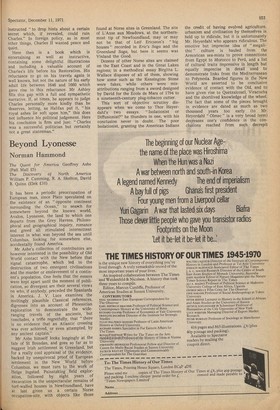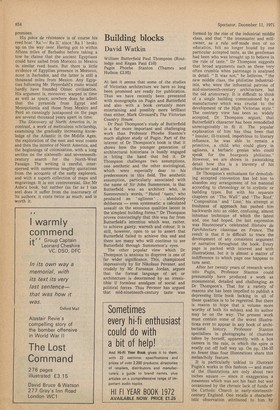Beyond Lyonesse
Norman Hammond
The Quest for America Geoffrey Ashe (Pall Mall £5) The Discovery of North America William P. Cumming, R. A. Skelton, David B. Quinn (Elek £10)
It has been a periodic preoccupation of European man, since Plato speculated on the existence of an "opposite continent surounding the Ocean," to seapch for somewhere beyond the known world, Avalon, Lyonesse, the land to which one departs from the Grey Havens. Philosophical and geographical inquiry, romance and greed all stimulated intermittent interest in what was beyond the sea until Columbus, looking for somewhere else, accidentally found America.
Mr Ashe's collection of contributors are however interested in the possibility of Old World contact with the New before that signal catastrophe, which led to the destruction of two emergent civilisations and the murder or enslavement of a continent's population. One feels that the essays were kept apart until the moment of publication, so divergent are their several views On who, if anybody, preceded the Spaniards in America. J. V. Luce examines the invitingly plausible Classical references, digresses into an accciunt of Phoenician exploration to demonstrate the wideranging travels of the ancients, • but concludes, a trifle regretfully, that "there is no evidence that an Atlantic crossing was ever achieved, or even attempted, by any ancient captain."
Mr Ashe himself looks longingly at the tale of St Brendan, and goes so far as to suggest Irish settlement in Greenland, but for a really cool appraisal of the evidence, backed by unequivocal proof of European settlement in the New World before Columbus, we must turn to the work of Helge Ingstad. Painstaking field exploration, followed by eight years of excavation in the unspectacular remains of turf-walled houses in Newfoundland, have at last given us a certain Norse occupation-site, with objects like those found at Norse sites in Greenland. The site of L'Anse aux Meadows, at the northernmost tip of Newfoundland, may or may not be that of Leif Ericsson's "big houses" recorded in Eric's Saga and the Greenland Saga, but here it seems was Vinland the Good.
Dozens of other Norse sites are claimed on the East Coast and in the Great Lakes regions; in a methodical essay Birgitta L. Wallace disposes of all of them, showing how some such as the Kensington Stone were fakes, while others were misattributions ranging from a sword designed by David for the Ecole de Mars of 1794 to a nineteenth-century plug-tobacco cutter.
This sort of objective scrutiny disappears when we come to Thor Heyerdahl's two essays. "Isolationist or Diffusionist?" he thunders in one, with his conclusion never in doubt. The poor Isolationist, granting the American Indians
the credit of having evolved agriculture, urbanism and civilisation by themselves is held up to ridicule, but it is unfortunately Mr. Heyerdahl who appears ridiculous. The emotive but imprecise idea of " megalithic " culture is hauled from the Armorican sea-mists to prove connections from Egypt to Morocco to Peril, and a list of cultural traits impressive in length but equally imprecise in detail used to demonstrate links from the Mediterranean to Polynesia. Bearded figures in the New World are asserted to be conclusive evidence of contact with the Old, and to have given rise to Quetzalcoatl, Viracocha and the shortlived knowledge of the wheel. The fact that some of the pieces brought in evidence are dated as much as two thousand years too early (to Mr. Heyerdahl " Olmec " is a very broad term) decreases one's confidence in the conclusions reached from such decrepit
premises.
His piece de resistance is of course his reed boat Ra Ra II,' since ' Ra 1 ' broke up on the way over. Having got to within fifteen miles of Barbados before taking a tow he Claims that the ancient Egyptians could have sailed from Morocco to Mexico in similar reed boats. But there is little evidence of Egyptian presence in Morocco, none in Barbados, and the latter is still a thousand miles from Mexico. Any Egyptian following Mr. Heyerdahl's route would hardly have founded Olmec civilisation. His argument is, moreover, warped in time as well as space; nowhere does he admit that the pyramids from Egypt and Mesopotamia and those from Mexico and Peru so cunningly juxtaposed on the page are several thousand years apart in time.
The Discovery of North America is, in contrast, a work of meticulous scholarship, examining the gradually increasing knowledge of the Atlantic in the Middle Ages, the exploration of the east and west coasts and then the interior of North America, and the beginnings of colonisation, with a long section on the sixteenthand seventeenthcentury search for the North-West Passage. The writing is careful, interspersed with numerous lengthy quotations from the accQunts of the early explorers, and with a superb collection of maps and engravings. It is not controversial, like Mr Ashe's book, but neither (as far as I can see) does it suffer from the inaccuracy of Its authors; it costs twice as much, and is worth it.











































 Previous page
Previous page